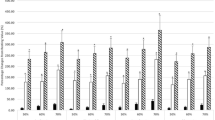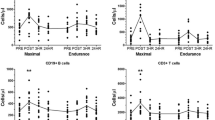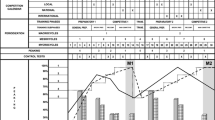Summary
Absolute (×103·mm−3) or relative (%) numbers of blood leucocyte types (monocytes, lymphocytes, neutrophils) and lymphocyte subsets (T11+, T4+, T8+, B1+, and NKH1+) reacting with specific monoclonal antibodies were determined at rest, immediately after maximal exercise on a treadmill, in six controls (C), and in six young cyclists before training (BT) and after 5 months of training (AT). Maximal exercise significantly increased the absolute number (mobilization) of virtually all the types of leucocytes and subsets of lymphocytes in C, BT and AT subjects. In these subjects mobilization of natural killer cells (NKH1+) and cytotoxic/suppressor T lymphocytes (T8+) was greater than mobilization of the other leucocyte types and lymphocyte subsets; however, maximal exercise induced no significant changes in the relative numbers of any leucocyte types and lymphocyte subsets, except in the case of T4+ lymphocytes in AT cyclists. Chronic submaximal exercise induced increased mobilization of neutrophils and decreased mobilization of lymphocytes during maximal exercise, except in the case of B lymphocytes (B1+) and NKH1+ cells, and decreases in the absolute and relative number of neutrophils at rest. It remains to be seen how these results can explain the modifications of leucocyte activities noted in vitro after isolated or chronic exercise.
Similar content being viewed by others
References
Berck LS, Nieman D, Tan SA, Nielsen-Cannarella S, Kramer J, Eby WC, Owens M (1986) Lymphocyte subset change during acute maximal exercise. Med Sci Sports Exerc 18:706
Bieger WP, Weiss M, Michel G, Weicker H (1980) Exercise-induced monocytosis and modulation of monocyte function. Int J Sports Med 1:30–36
Bishop CR, Athens JW, Boggs DR, Warner HR, Cartwright GE, Wintrobe MM (1968) Leukokinetics studies XIII. A nonsteady-state kinetic evaluation of the mechanism of cortisone-induced granulocytosis. J Clin Invest 47:249–254
Crary B, Hauser SL, Borysenko M, Kutz I, Hoban C, Ault KA, Weiner HL, Benson H (1983) Epinephrine induced changes in the distribution of lymphocyte subsets in peripheral blood of humans. J Immunol 131:1178–1181
Deuster PA, Curiale AM, Cowan ML, Finkelman FD (1988) Exercise induced changes in populations of peripheral blood mononuclear cells. Med Sci Sports Exerc 20:276–280
Doershuk CM, Allard MF, Lee S, Brumwell ML, Hogg JC (1988) Effect of epinephrine on neutrophil kinetics in rabbit lungs. J Appl Physiol 63:401–407
Dorner H, Heinold D, Hilmer W (1987) Exercise-induced leukocytosis — its dependence on physical capability. Int J Sports 8:152
Ferry A (1989a) Le sportif pourrait-il être immunodéprimé: premiers élements de réponse. Cinésiologie 126:12–16
Ferry A (1989b) Influences de l'exercice musculaire sur le systeme immunitaire: exemples d'immunomodulation. Sc Sports 4:25–40
Fitzgerald L (1988) Exercise and the immune system. Immunol Today 9:337–339
Foster NK, Martyn JB, Rangno RE, Hogg JC, Pardy RL (1986) Leukocytosis of exercise: role of cardiac output and catecholamines. J Appl Physiol 61:2218–2223
Frey MJ, Mancini D, Fischberg D, Wilson JR, Molinoff PB (1989) Effect of exercise duration on density and coupling of beta-adrenergic receptors on human mononuclears cells. J Appl Physiol 66:1495–1500
Gimenez M, Mohan-Kumar T, Humbert JC, De Talance N, Buisine J (1986) Leukocyte, lymphocyte and platelet response to dynamic exercise. Eur J Appl Physiol 55:465–470
Gimenez M, Mohan-Kumar T, Humbert JC, De Talance N, Teboul M, Belenguer FJ (1987) Training and leukocyte, lymphocyte and platelet response to dynamic exercise. J Sports Med 27:172–177
Green RL, Kaplan SS, Rabin BS, Stanitski CL, Zdziarski U (1981) Immune function in marathon runners. Ann Allergy 47:73–75
IP SH, Rittershaus CW, Healey KW, Struzziero CC, Hoffman RA, Hansen PW (1982) Rapid enumeration of T lymphocytes by a flow cytometric immunofluorescence method. Clin Chem 28:1905–1909
Katz P, Zaytoun AM, Lee JH (1984) The effects of in vivo hydrocortisone on lymphocyte-mediated cytotoxicity. Arthritis Rheum 27:72–78
Keast D, Cameron K, Morton AR (1988) Exercise and the immune system. Sports Med 5:248–267
Kjaer M, Farell PA, Christensen NJ, Galbo H (1986) Increased epinephrine response and inaccurate glucoregulation in exercising athletes. J Appl Physiol 61:1693–1700
Landmann RMA, Muller FB, Perini CH, Wesp M, Erne P, Buhler FR (1984) Changes of immunoregulatory cells induced by psychological and physical stress: relationship to plasma catecholamines. Clin Exp Immunol 58:127–135
Lewicki R, Tchorzewski H, Denys A, Kowalska M, Golinska A (1987) Effect of physical exercise on some parameters of immunity in conditioned sportsmen. Int J Sports Med 8:309–314
Lewicki R, Tchorzewski H, Majewska E, Nowak Z, Baj Z (1988) Effect of maximal physical exercise on T lymphocyte subpopulations and on interleukine 1 and interleukine 2 production in vitro. Int J Sports Med 9:114–117
Masuhara M, Kami K, Umebayashi K, Tatsumi N (1987) Influences of exercise on leukocyte count and size. J Sports Med 27:285–290
Oshida Y, Yamanouchi K, Hayamizhu S, Sato Y (1988) Effect of acute physical exercise on lymphocyte subpopulations in trained and untrained subjects. Int J Sports Med 9:137–140
Simon H (1984) The immunology of exercise. JAMA 252:2735–2738
Soppi E, Varjo P, Eskola J, Laitinen LA (1982) Effect of strenuous physical stress on circulating lymphocyte number and function before and after training. J Clin Lab Immunol 8:43–46
Stein M, Keller SE, Schleifer SJ (1985) Stress and immunomodulation: the role of depression and neuroendocrine function. J Immunol 135:827–833
Watson RR, Moriguchi S, Jackson JC, Turner L, Wilmore J, Freund BJ (1986) Modification of cellular immune functions in humans by endurance exercise training during beta-adrenergic blockade with atenolol or propranolol. Med Sci Sports Exerc 18:95–100
Author information
Authors and Affiliations
Rights and permissions
About this article
Cite this article
Ferry, A., Picard, F., Duvallet, A. et al. Changes in blood leucocyte populations induced by acute maximal and chronic submaximal exercise. Europ. J. Appl. Physiol. 59, 435–442 (1990). https://doi.org/10.1007/BF02388625
Accepted:
Issue Date:
DOI: https://doi.org/10.1007/BF02388625




